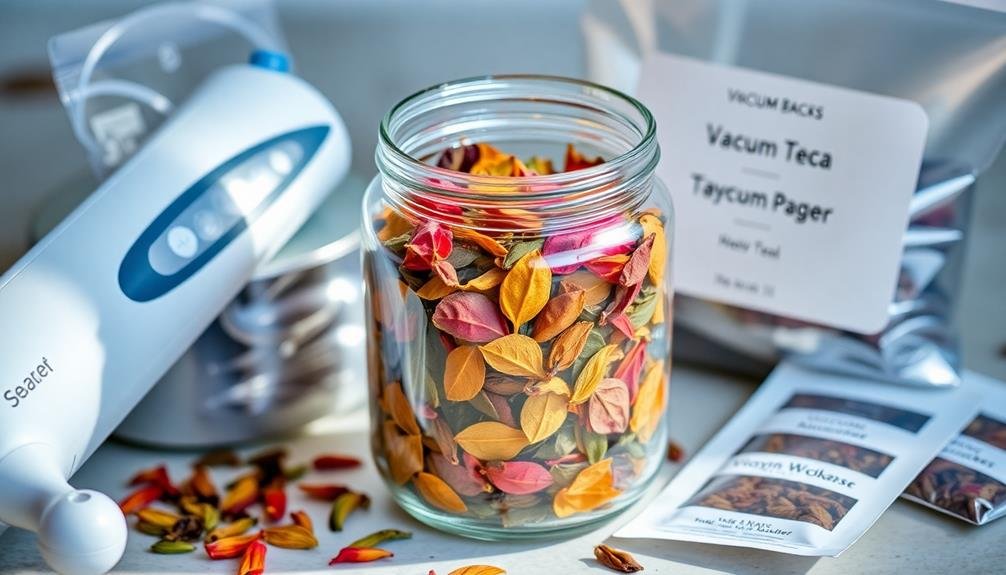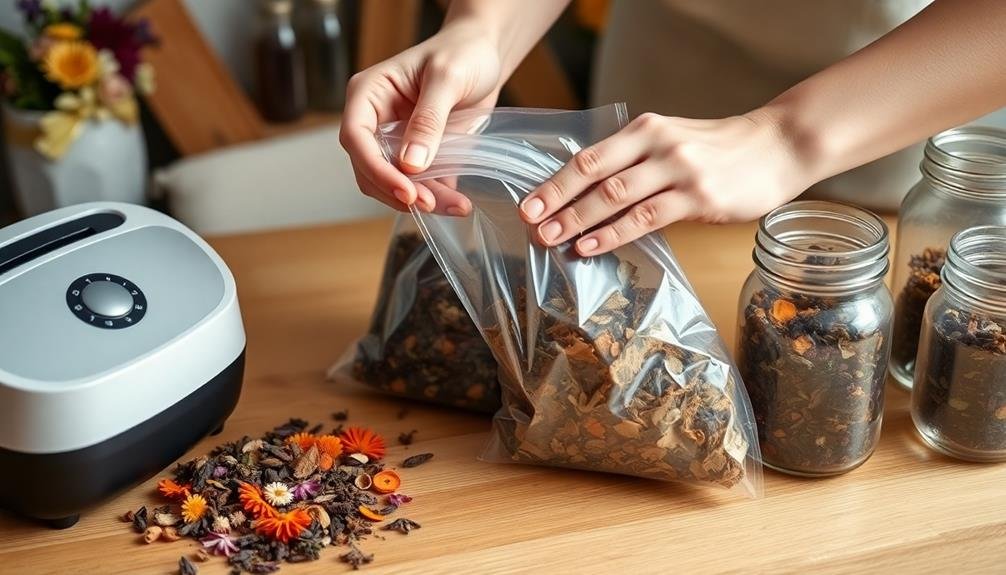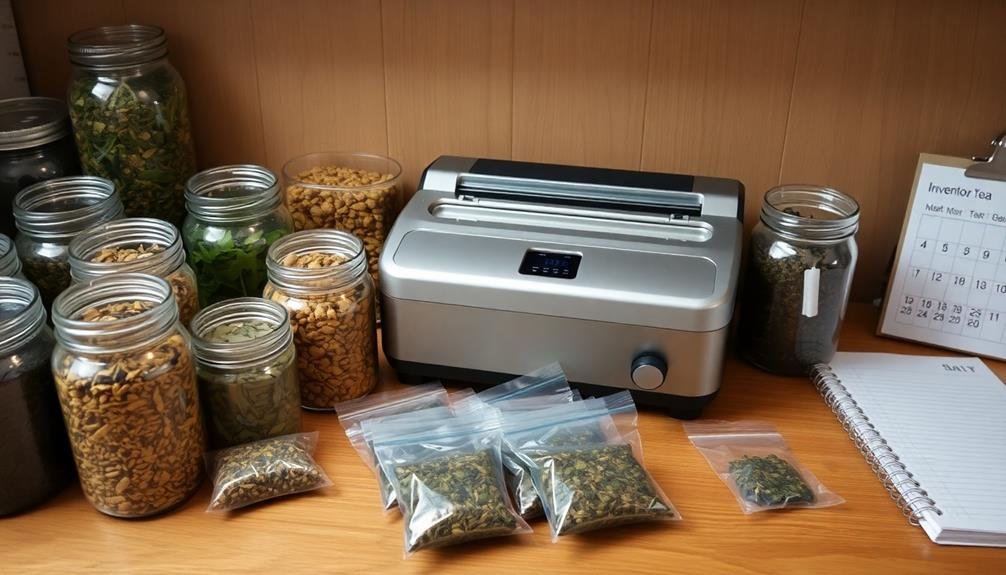To preserve your herbal tea's freshness with vacuum-sealing, start by selecting the right equipment with adjustable suction and pulse functions. Verify your herbs are completely dry and crumble them into smaller pieces before sealing. Use proper techniques like arranging herbs in a single layer and double-sealing for extra protection. Store your sealed teas in a cool, dark place with ideal temperature and humidity levels. Implement a tracking system and rotate your inventory regularly to maintain freshness. By mastering these tips, you'll extend the life of your herbal teas and enjoy their full flavor for months to come. Discover more ways to enhance your tea preservation methods below.
Choose Ideal Vacuum Sealing Equipment

Vacuum sealers are essential tools for preserving herbal tea freshness. When selecting the ideal equipment, consider both handheld and countertop models. Handheld sealers are portable and perfect for small batches, while countertop units offer more power and versatility for larger quantities.
Look for a vacuum sealer with adjustable suction strength. This feature allows you to control the amount of air removed, preventing delicate tea leaves from being crushed. Opt for a model with a pulse function, which gives you precise control over the sealing process.
Choose a sealer compatible with various bag sizes and types. Some models work with both pre-cut bags and roll materials, offering flexibility in storage options. Confirm the sealer can handle different textures, from fine powders to whole leaf teas.
Consider additional features like built-in bag cutters, jar attachments, and marinate modes. These extras can enhance your tea storage capabilities.
Don't forget to check the warranty and customer support options, as well as the availability of replacement parts and accessories.
Lastly, read user reviews and compare prices to find the best value for your needs. A quality vacuum sealer will greatly extend your herbal tea's shelf life and maintain its flavor profile.
Prepare Herbs for Vacuum Sealing
Preparation is key to successful vacuum sealing of herbal teas. Before you begin, verify your herbs are completely dry to prevent mold growth. Spread them out on a clean, dry surface and allow them to air dry for several days. Once dry, gently crumble the herbs into smaller pieces, but avoid grinding them into a powder. This will help maintain their flavor and aroma while maximizing storage space.
Sort your herbs by type and remove any stems, discolored leaves, or foreign matter. Consider blending complementary herbs for custom tea mixes. When handling the herbs, use clean, dry hands or utensils to avoid introducing moisture or contaminants.
Here's a quick guide to preparing common herbs for vacuum sealing:
| Herb Type | Drying Time | Preparation Method |
|---|---|---|
| Mint | 3-5 days | Whole leaves |
| Chamomile | 1-2 weeks | Whole flowers |
| Lavender | 1-2 weeks | Buds only |
Once prepared, portion your herbs into serving sizes or larger quantities depending on your needs. This step will make it easier to use your vacuum-sealed herbs without exposing the entire batch to air each time you open a package.
Proper Sealing Techniques

When it comes to proper sealing techniques, you'll want to follow a few key steps to guarantee your herbal teas remain fresh and flavorful.
First, verify your vacuum sealer is clean and functioning correctly. Place the prepared herbs in an appropriate-sized vacuum bag, leaving about 3 inches of space at the top for sealing.
Arrange the herbs in a single layer to prevent clumping and verify even distribution. Gently shake the bag to settle the contents, then smooth out any wrinkles or folds in the plastic. This helps create a strong, airtight seal.
Position the open end of the bag in the vacuum sealer's chamber, making sure it's centered and flat. Activate the sealer and watch as it removes the air and seals the bag. If your machine has adjustable settings, choose the appropriate level for delicate herbs to avoid crushing them.
Once sealed, inspect the bag for any gaps or imperfections. If you notice any issues, cut open the seal and start again.
For extra protection, you can double-seal the bag by creating a second seal about 1/4 inch above the first one.
Optimal Storage Conditions
Three key factors contribute to ideal storage conditions for your vacuum-sealed herbal teas: temperature, light, and humidity.
For peak freshness, store your teas in a cool, dark place with stable temperatures between 60-70°F (15-21°C). Avoid areas prone to temperature fluctuations, like near stoves or windows. Excessive heat can degrade tea quality and flavor.
Keep your vacuum-sealed teas away from direct sunlight and artificial light sources. UV rays can break down the delicate compounds in herbs, altering taste and reducing beneficial properties. A pantry, cupboard, or drawer provides excellent protection from light exposure.
Control humidity levels to prevent moisture from compromising your tea's integrity. Aim for a relative humidity of 50-60%. Higher humidity can lead to mold growth, even in vacuum-sealed packages.
If you live in a humid climate, consider using silica gel packets or storing your teas in an airtight container with a tight-fitting lid.
Monitoring and Rotating Tea Inventory

Your herbal tea collection's longevity depends on regular monitoring and rotation. Implement a system to track your tea inventory, including purchase dates and expiration timelines. Create a spreadsheet or use a mobile app to log this information, making it easy to identify which teas need to be consumed first.
Conduct monthly inspections of your tea storage areas. Look for signs of moisture, pest intrusion, or packaging damage. If you notice any issues, address them immediately to prevent spoilage. During these checks, reorganize your teas, moving older batches to the front and newer ones to the back.
Practice the "first in, first out" (FIFO) method. Use the oldest teas first to guarantee you're always consuming the freshest possible product. This approach also helps you avoid forgetting about older teas that might get pushed to the back of your storage area.
Set reminders to review your inventory every few months. This will help you identify teas that are nearing their expiration dates, allowing you to plan your consumption accordingly. It's also an opportunity to assess which teas you're using most frequently and adjust your purchasing habits to minimize waste.
Frequently Asked Questions
Can Vacuum-Sealed Herbal Teas Be Resealed After Opening?
Yes, you can reseal vacuum-sealed herbal teas after opening. You'll need a vacuum sealer machine or special bags with built-in valves. Simply place the tea in the bag, remove the air, and seal it again for freshness.
How Long Do Vacuum-Sealed Herbal Teas Typically Last?
You'll find that vacuum-sealed herbal teas typically last 1-2 years. However, they're best consumed within 6-12 months for ideal flavor. After opening, you should use them within 3-6 months for the freshest taste.
Are There Any Herbal Teas That Shouldn't Be Vacuum-Sealed?
You shouldn't vacuum-seal delicate herbal teas like chamomile or lavender, as they can be crushed. Oily herbs like peppermint may also lose flavor. It's best to store these in airtight containers instead of vacuum-sealing them.
Can Vacuum-Sealed Herbal Teas Be Stored in the Freezer?
You can store vacuum-sealed herbal teas in the freezer. It's an excellent way to extend their shelf life and preserve flavor. However, you'll need to let them thaw completely before opening to prevent moisture from damaging the tea.
Does Vacuum-Sealing Affect the Flavor or Aroma of Herbal Teas?
Vacuum-sealing can actually enhance your herbal tea's flavor and aroma. It'll protect the delicate compounds from air exposure, preserving their freshness longer. You'll notice your teas stay more vibrant and aromatic when you brew them.
In Summary
You've now learned the essential steps to preserve your herbal tea's freshness through vacuum-sealing. By choosing the right equipment, preparing herbs properly, using correct sealing techniques, storing in ideal conditions, and monitoring your inventory, you'll guarantee your teas stay flavorful for longer. Don't forget to rotate your stock regularly. With these tips, you'll always have fresh, aromatic herbal teas at your fingertips. Enjoy your perfectly preserved teas and savor every cup!





Leave a Reply